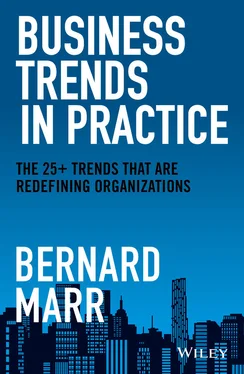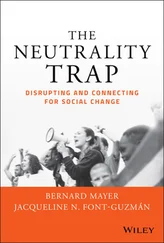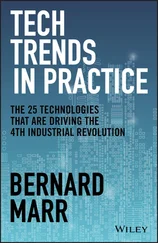Storing and processing data
Computers have had to get faster and more powerful, in part to keep up with the vast amounts of data we're generating and processing. I talk more about the increasing datafication of our world later in the chapter, but it's clear that we're creating a vast amount of data on a daily basis. And the technology to store all that data is now significantly cheaper, more powerful, and easier to access. As a simple example, in the mid-1960s a terabyte of storage would have cost $3.5 billion; today I can buy a 1TB hard drive for less than $50.
Cloud computing (where data and applications are stored and processed on other people's computers) has played a critical role in the digital transformation we've seen in recent years, bringing huge advantages in terms of storing data cheaply, keeping data secure, and being able to process data more easily (most cloud providers offer AI and analytics services that can help you interrogate data at the click of a button).
So it's no surprise that as much as 80 percent of all enterprise and mission-critical workloads are predicted to move to the cloud by 2025. 2 The cloud has become the backbone of the data-driven, app-based tech ecosystem that modern businesses operate in, and it continues to evolve. One trend that we can expect to see more of in cloud computing is multi-cloud approaches, or a breaking down of the barriers between different cloud service providers like Amazon, Microsoft, and Google. There are growing calls for the big providers to adopt a more collaborative approach and create bridges between their platforms, allowing, for example, an Amazon Web Services client to share data and access with a partner in their supply chain who works with Microsoft Azure.
Outside of the cloud, as devices have become more powerful, they've also been able to take on more of the processing grunt work. Known as edge computing , this means instead of pushing every bit of data to the cloud for analysis, some of it can be processed at the source, where the data was collected (i.e., in the device itself). This will become more important, and more useful, as 5G rolls out. Bringing with it superfast broadband and faster response times, 5G will make “the edge” much more powerful than it is today, effectively allowing us to turn everything around us into computers.
There are other data storage innovations to watch out for, the most exciting of which is DNA storage. Yes, you read that correctly. I'm talking about the ability to store data on DNA. Data centers are energy-hungry resources, and we can't ignore the impact all this data we're creating has on the planet. DNA-based storage could provide a solution to this problem, and a number of companies, including Microsoft, are working on DNA-storage technology. It's not as crazy as it sounds; DNA is already routinely sequenced (read), copied, and synthesized (written to), and storing DNA doesn't take much energy. What's more, DNA can store huge amounts of information – far more than any electronic devices. A block of DNA measuring just one cubic meter could meet the world's current data storage needs for a year. 3 Which is just as well, because the rise of smart, connected devices – devices that are constantly gathering and generating data – shows no sign of slowing down.
Trend 2: Connected and Smart Everything
You'll no doubt be familiar with the Internet of Things (IoT) from devices like smart TVs, smart watches, and smart thermostats. The IoT refers to the increasing number of intelligent devices and objects that are connected to the internet and are capable of gathering and transmitting data. The IoT is now growing at such a rate that we have intelligent, well, everything. It's hard to pinpoint the exact number of connected devices on the planet, but some estimates suggest that by 2030 as many as 50 billion IoT devices will be installed worldwide. 4 That's more than 6 times the number of people on the planet.
And by intelligent everything, I mean everything . Yoga mats, lightbulbs, cars, robots, drones, ships — these and many more are becoming “smart,” meaning they're capable of connecting to the internet, gathering data on what's going on around them, communicating that data with other devices or platforms, and often making decisions or taking action based on the data. Looking ahead, it's clear that anything that can be connected, will be. One cool example comes from the US Navy's Sea Hunter autonomous unmanned surface vehicle prototype (basically, an autonomous drone ship). Sea Hunter has already sailed autonomously from California to Hawaii and back without the need for a crew, and is being integrated into a naval carrier strike group, 5 meaning sailors will have to get used to operating alongside unmanned ships.
And this notion of smart everything doesn't just relate to devices and products (although that is obviously a key consideration for businesses); it also relates to intelligent spaces. From smart, connected factories and offices to entire smart cities, the spaces around us are increasingly being equipped with the ability to monitor what's going on and act accordingly. For example, public transportation routes can be adjusted in real time according to demand, or traffic flows can be monitored and analyzed to improve congestion. Alibaba's City Brain system uses AI to optimize a city's infrastructure, and in the Chinese city of Hangzhou, it has helped reduce traffic jams by 15 percent. 6
Of course, this pervasive connectivity brings with it increased security risks. Connecting anything to the internet makes it vulnerable to cyberattack, which makes securing connected devices and spaces all the more important.
This ability to connect things and places to the internet (and to each other) has the potential to transform many industries, including manufacturing, education, healthcare, and defense. Perhaps most importantly for many businesses, this notion of connected everything provides a unique insight into how customers (and employees for that matter) really behave, versus how they say they behave. Manufacturers of connected cars, for instance, can understand when, where, and how their customers drive. This sort of knowledge is profoundly useful to businesses in terms of understanding how customers use products, designing future products, increasing customer satisfaction, and more. This is why data can be considered one of the most important assets modern businesses have at their disposal. And that brings us to the next topic.
Trend 3: The Datafication of Our World
Ubiquitous computing and the IoT are both huge contributors to the sheer volume of data that's being generated on a daily basis. But alongside machine-generated data, we humans are also generating masses of data through our daily activities. Everything we do leaves a digital trace. From liking a video on TikTok to buying gas with your credit card, so many of our everyday activities generate streams of data. As such, we've seen huge advances in the way data is stored. It's not just about data warehouses anymore; now we have data lakes , where data is stored in a less-structured way, with data rivers continuously flowing into those lakes. And, as I've already mentioned, we have futuristic advances such as DNA data storage to look forward to.
For businesses, the obvious advantage of all this data is that it can be harnessed to design better products and services, improve business processes, enhance decision-making, and even create new revenue sources (take a company like John Deere as an example, which has been able to package up the data collected from its farming machinery and sell it back to farmers).
Two of the biggest concerns around data are privacy and security. When everything we do leaves a digital trace, this can have massive implications for our individual privacy, so it's vital that businesses take steps to protect people's privacy. For me, this means only collecting data that you really need (and not collecting everything for the sake of it), making people aware of exactly what data you're collecting (and why), and offering them the chance to opt out where possible. Looking ahead, we can expect to see a significant tightening of regulations designed to protect people's privacy. Security-wise, while the number of breaches has declined since 2019, the severity of breaches has increased – to the extent that 37 billion sensitive records were compromised in 2020, an increase of 141 percent on the previous year. 7 And in February 2021, the largest breach of all time was leaked online. COMB, or Compilation of Many Breaches, as it's being called, contained 3.2 billion emails and passwords – roughly 40 percent of the entire population of the planet. 8 Data is a valuable asset, but it also brings with it considerable business risk.
Читать дальше












